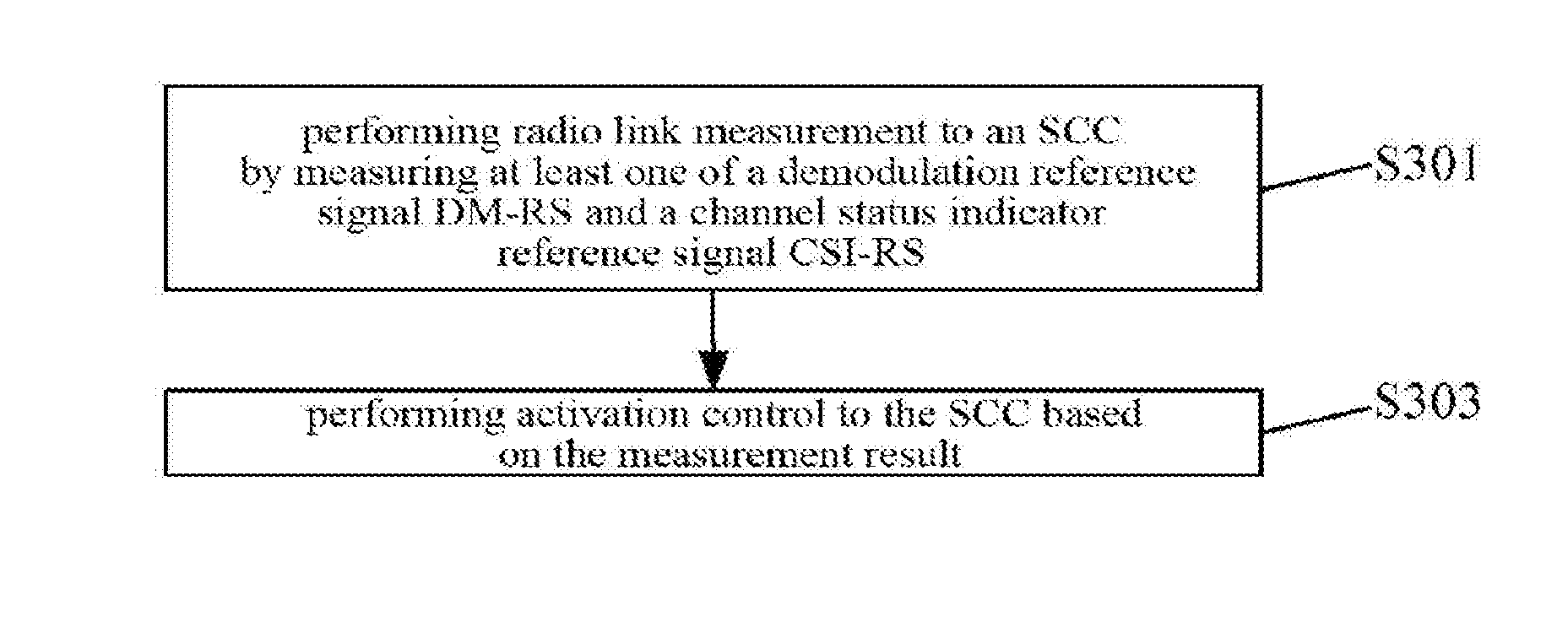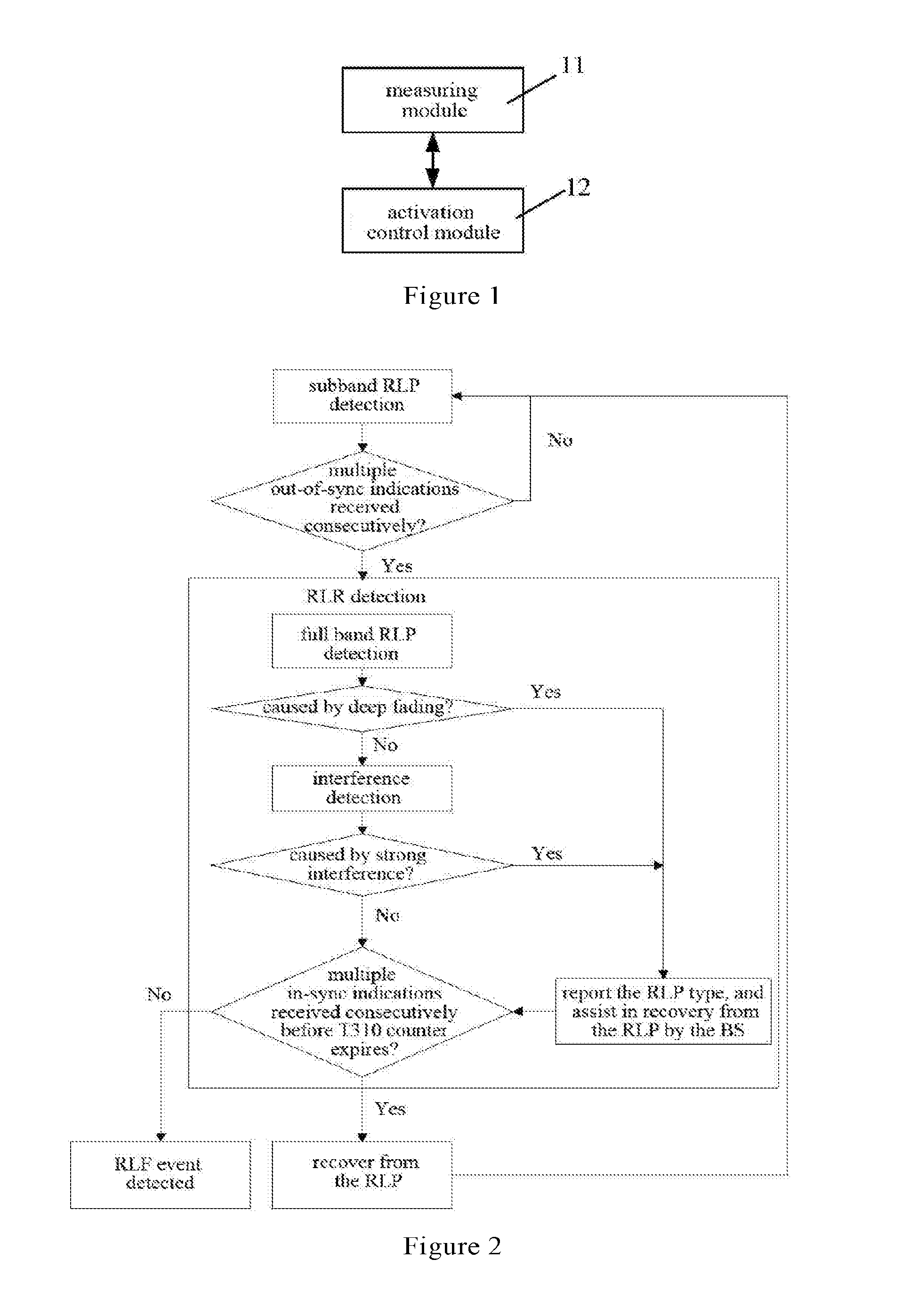Nct scc activation control device and method, management method and base station device
a control device and secondary component carrier technology, applied in the field of communication, can solve the problems of reducing crs solutions, dm-rss and psss/ssss in nct collision, and increasing the complexity of ue, so as to facilitate the realization of activation control/management, accurate and reasonable measurement of nct sccs
- Summary
- Abstract
- Description
- Claims
- Application Information
AI Technical Summary
Benefits of technology
Problems solved by technology
Method used
Image
Examples
example 1
[0120]The UE communicates with the BS using NCT and performs subband RLP detection to the ePDCCH of NCT. The specific steps are as below:
(1) measuring a DM-RS on an NCT ePDCCH, and mapping a measurement result as BLER transmitted in a given DCI format;
(2) comparing the BLER with a predetermined threshold, and sending an out-of-sync instruction to a higher level if the threshold is exceeded;
(3) the UE determining that RLP is detected if N310 out-of-sync indications are received consecutively, and preparing to enter the RLR process.
[0121]RLP detection can be performed to PDSCH on NCT similarly. The specific solution is similar to the measurement solution of ePDCCHs described in this example. The difference is that the threshold for assessment is the overall efficiency of current PDSCH transmission obtained based on the BLER estimate and the MCS information.
example 2
[0122]After the UE detects an RLP, the cause of the RLP needs to be identified. The specific steps are as below:
(1) configuring Reduced-RS or CSI-RS-based full band measurement;
(2) comparing a subband measurement result (indicated by RSRP / RSRQ) with an average full band measurement result;
(3) if the subband measurement result is lower than the average full band measurement result, determining that RLP is caused by local frequency band deep fading;
(4) reporting an assessment result to the BS by the UE through UL PCC, with CQI information identifying the current subbands with the best channel quality; and
(5) the BS performing frequency diversity or frequency domain position adjustment to the ePDCCH based on a reporting result of the UE.
[0123]If the full band measurement result indicates that the RLP is not caused by local frequency band deep fading, interference measurement is configured according to the following steps:
performing interference measurement to the subbands and the whole...
example 3
[0125]After detecting an RLP, the UE needs to perform link recovery through an RLR process. If the recovery fails, then RLP occurs. The RLR detection process of NCT is as below:
(1) measuring a DM-RS on an NCT ePDCCH, and mapping a measurement result as BLER transmitted in a given DCI format;
(2) comparing the BLER and a predetermined threshold, and sending an in-sync indication to a higher level if the BLER is lower than the threshold;
(3) determining that the UE is recovered from the RLP if N311 sync indications are received by the T310 timer consecutively.
[0126]RLR detection can be performed to NCT PDSCH based on DM-RSs similarly. The difference is that the threshold for assessment is the overall efficiency of the current PDSCH transmission obtained based on the BLER estimate and the MCS information.
[0127]In addition to subband RLR detection, a Reduced-CRS-based wide band RLR detection method can be configured.
[0128]An embodiment of this invention provides an NCT SCC activation cont...
PUM
 Login to View More
Login to View More Abstract
Description
Claims
Application Information
 Login to View More
Login to View More - R&D
- Intellectual Property
- Life Sciences
- Materials
- Tech Scout
- Unparalleled Data Quality
- Higher Quality Content
- 60% Fewer Hallucinations
Browse by: Latest US Patents, China's latest patents, Technical Efficacy Thesaurus, Application Domain, Technology Topic, Popular Technical Reports.
© 2025 PatSnap. All rights reserved.Legal|Privacy policy|Modern Slavery Act Transparency Statement|Sitemap|About US| Contact US: help@patsnap.com



